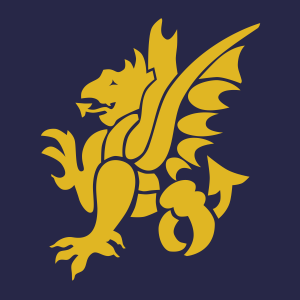Exhibition: Cornwall’s Citizen Army
Welcome!
This online exhibition is about the history of the Territorial Army. It was produced as part of a temporary physical exhibition which was on display in the museum between August 2020 and July 2021.
Introduction
The Territorial Army was a body of men and women who were civilian volunteers. They were recruited and enrolled locally, paid, and trained to serve as part-time soldiers. Today they are known as the Reserve Forces.
This exhibition includes objects, archives and photographs from the museum’s collection and tells the story of the TA’s evolution nationally and its role in Cornwall as the volunteer force of the Duke of Cornwall’s Light Infantry (DCLI). It also looks at some of the Drill Halls that were home to the TA in towns across the County.
If you have memories or memorabilia from the Territorial Army or Reservists in Cornwall, we’d be delighted to hear from you. Please get in touch by emailing: info@bodminkeep.org
The Origins of the Territorial Army
The Territorial Force
Volunteer military groups existed in Britain for centuries before they were organised into their modern form on 1st April 1908 by Richard Haldane, Secretary of State for War. He created a new Territorial Force which was the forerunner of the Territorial Army formed by Winston Churchill in 1921.
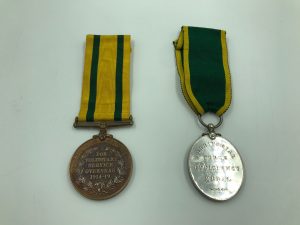
Pre-1921
These medals were awarded to Private W H Tallins DCLI, the Territorial Force War Medal is the rarest of the five British Great War medals. It was established in April 1920 for members of the Territorial Force and Territorial Force Nursing Service who had volunteered for before 30th September 1914 for service overseas.
The Boer War and the Territorial Force
The Territorial Force (TF) was designed to reduce defence expenditure after the second Boer War (1899-1902). This had been the most expensive war in history at a cost of £211 million, around £250 billion at today’s prices. The new Territorial Force organisation merged the 19th-century Volunteer Force and local yeomanry into a unified support force for the regular army which could be called upon when needed. It was commanded by the War Office and administered by local County Territorial Associations. Haldane’s vision was for a nation that could be mobilised for war without resorting to forced conscription.
“A real national army formed by the people”. Haldane
The DCLI TA - 1881 to the Eve of World War 1
The Duke of Cornwall’s Light Infantry (DCLI) regiment was created on 1st July 1881 as part of the Childer Reforms. The 32nd (Cornwall Light Infantry) Regiment of Foot merged with the 46th (South Devonshire) Regiment of Foot.
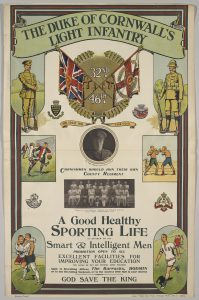
DCLI Recruiting Poster courtesy of the National Army Museum
The DCLI also incorporated the militia and rifle volunteers of Cornwall as the Regiment’s volunteer battalions. These volunteer battalions were not normally required to serve outside the United Kingdom. However, in the Second Boer War (1899-1902 ) the DCLI Volunteer Battalions contributed “Active Service Companies” that reinforced the regular battalions and were awarded the battle honour “South Africa 1900–1901″.
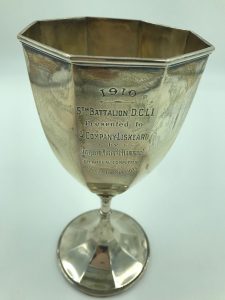
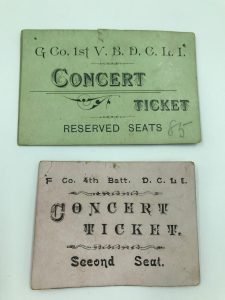
Silver Cup 1910 and Concert Tickets pre-1907
In 1908 the Haldane Reforms led to the volunteer battalions becoming part of the new ‘Territorial Force’. The three DCLI reserve battalions became the –
• 3rd (Special Reserve) Battalion based at Bodmin Keep (the DCLI’s regimental depot),
• 4th (Territorial Force) Battalion based at New Bridge Street in Truro and
• 5th (Territorial Force) Battalion based at Honey Street in Bodmin.
Royal Cornwall Gazette 14th August 1890
Apply, in writing, to C DAVIES GILBERT, Esq., Trelissick. WANTED, RECRUITS FOR THE DUKE of CORNWALL’S LIGHT INFANTRY. YOUNG Men wishing to Join the Army, or Militia, can obtain a statement of the Conditions, Pay, and other Advantages
The Territorials in World War 1
The Territorials on the Front Line
In 1914 at the start of World War 1, the Territorial Force was mobilised and served alongside the regular army. Although not compelled to serve overseas, they volunteered and fought on The Western Front. In 1914 the British Expeditionary Force was nearly destroyed, and the Territorial Force provided much needed additional manpower to fill the gap.
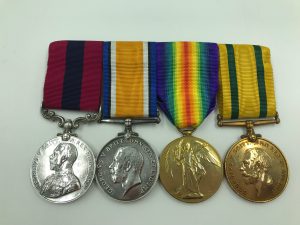
Distinguished Conduct Medal On left with British War Medal, Victory Medal and Territorial War Medal)
1918
Awarded to W E White, who had been a Territorial soldier before the outbreak of World War One, serving with the 4th Battalion DCLI.
Because of his brave actions in March 1918, W E White was awarded the medal for conspicuous gallantry and devotion to duty. This included leading the rescue of buried and injured soldiers after the collapse of a trench by shell fire, and then manning the post alongside his company.
By the war’s end, the Territorial Force had
• fielded 23 infantry divisions and 2 mounted divisions on foreign soil, amounting to many thousands of men
• won 71 Victoria Crosses Britain’s highest award for valour
• suffered some 577,000 casualties in the period 1914–1920
(A division is a large military unit or formation, usually consisting of between 10,000 and 20,000 soldiers. Infantry divisions during the World Wars ranged between 8,000 and 30,000.)
Following the Armistice, all Territorial Force units were gradually disbanded.
Between the Two World Wars
A Time of Cuts and Change
After the First World War, Britain was gripped by enormous debts and there was a growing sense of panic that the Government was hugely wasteful. The national debt had risen dramatically and the vast civil service that had come together to administer the war effort was still operating at full capacity. Many of the middle classes complained about how their tax bills had shot up.
In this context, the Territorial Force had developed a reputation for being a poorly-trained, poorly equipped, poorly-led and generally inefficient organisation and after 1918 there began a long debate about its future. This resulted in Winston Churchill, then Secretary of State for War, officially reconstituting the Territorial Force into a new Territorial Army (TA) in 1921.
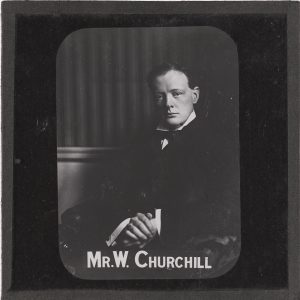
A young Winston Churchill, photo courtesy of the National Army Museum
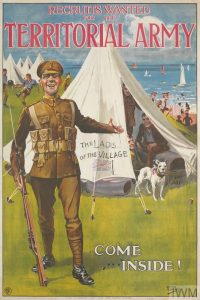
Poster Courtesy of the Imperial War Museum
The Government was under pressure and the Prime Minister David Lloyd George appointed businessman Sir Eric Geddes to head up a new Committee on National Expenditure, which was soon dubbed “The Great Axe”.
The biggest cuts that Geddes made were in the Army and Navy, with total defence expenditure falling from £189.5 million in 1921-22 to £111 million in 1922-23. The newly formed Territorial Army did not escape the axe and was significantly reduced in size. The annual payments for being in the TA, (known as ‘bounty’) were also reduced, to £3 for trained men and £2 10 shillings (£2 50) for new recruits. In total, the TA cuts found £1,175,000 of the total savings from the Army.
The DCLI TA in World War 2
The 5th Battalion
During the 1930s, tensions increased between Germany and Britain and its Allies. As the threat of war loomed, on 29th March 1939 the Secretary of State for War, Leslie Hore-Belisha, announced plans to increase the Territorial Army from 130,000 to 340,000 men. In September 1939 Britain went to war with Germany and the TA became an integral part of the Regular Armed Forces and was no longer a separate reserve force.
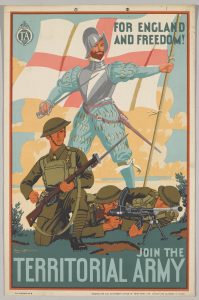
Poster Courtesy of the National Army Museum
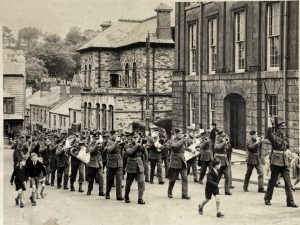
The DCLI Band marching through Bodmin in 1940
During World War 2 the DCLI TA became the 5th Battalion and took part in many battles. Landing in Normandy on the 23rd June 1944 they were soon heavily engaged in the fight for Hill 112, a strategic objective for control of the surrounding area.
‘He who commands Hill 112, commands Normandy’. Field Marshall Rommel
Over the following weeks Hill 112 changed hands several times in fierce fighting, until finally it was taken by the British on 4th August 1944. Hill 112 later became known as ‘Cornwall Hill’ in memory of those many Cornish men who died fighting to capture it.
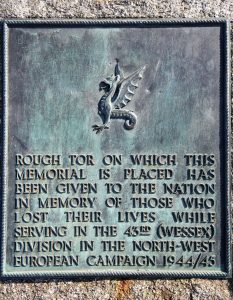
Memorial on Roughtor, Bodmin Moor
National Service and the TA
A Call to Arms
In the years following World War 2, its impact was still everywhere to be seen. Britain and her allies were victorious, but the country was bankrupt. People were war weary and everywhere there were vacant bomb sites, unrepaired houses, temporary prefabs and gardens turned into allotments. The countryside was peppered with wartime military bases, many now abandoned. Others, like Bodmin Barracks, were reactivated in response to the Cold War.
In 1947, National Service was introduced and all able-bodied men of 18 and over were required to serve in the Armed Forces for 2 years. By the time it ended in the late 1950s 2.3 million young men had served, most of them in the Army.
After completing their 2 years, National Servicemen went back to civilian life but were legally required to do another three years in the TA. This gave the TA a new lease of life by providing a trained pool of men to call on in time of need.
Why Did People Join the TA?
Saturday Night Soldiers – For a Few Bob More!
The TA was made up of people from many walks of life who joined for a variety of reasons. Training was one reason to join, with men able to access training in the full range of roles and women in some specialist roles such as medics, clerks and drivers. Some joined for the social life, the sports and adventure, the camaraderie and some simply joined to earn ‘a few bob more’. One recruit in the Duke of Cornwall’s Light Infantry TA, based at Camelford, joined because they had a nice snooker table and a new bar!
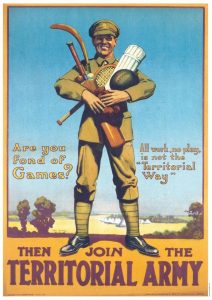
For some it was a paid opportunity to handle and fire weapons, drive armoured vehicles and be a part-time soldier. Many former soldiers who missed the military life joined the TA to continue being part of the Armed Services.
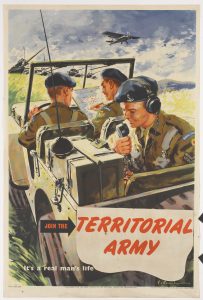
Poster from the 1960s Courtesy of the National Army Museum
Between 1947 and 1963, it was compulsory to serve 3 years in the TA after completing 2 years National Service. Some resented this further obligation whilst others saw it as an opportunity. Life post-war was hard, with rationing still in place until 1954 and severe shortages of most consumer products. This meant that the wartime ‘make-do-and-mend’ culture continued well into the 1960s. Most people had little surplus money and what you were paid to be in the TA and to attend training, known as the ‘bounty’, could make a real difference in times of austerity.
The annual TA Bounty payment in
• 1930’s was approximately £5.
• 1952 it had gone up to £12
• 1972 it was £60
• 2020 it is approximately £2000.
Training in the TA
From Civilian to Soldier
The TA followed the same training regime as the Regular Armed Forces and was organised and led in the same way. They met twice-weekly at their unit’s Drill Hall, usually from 7 to 9 pm and on specified weekends. They also attended an annual training camp where they carried out military exercises. Specialist TA Units like the Royal Engineers offered training that was useful in civilian life, such as plant operation and mechanical engineering.
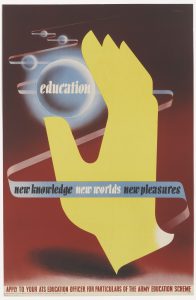
Poster courtesy of the National Army Museum
In the years following the Second World War, the Territorial Army carried out most of its annual training at camps close to their home locations. Plasterdown Camp near Tavistock, which had been built in 1943 as a US Army hospital to deal with casualties from the Normandy landings, was only an hour from Bodmin and was used by the DCLI (TA) for its training exercises. Plasterdown continued to be used by the military into the 1960s and was also used to house Ugandan refugees in 1972 before being demolished in 1976.
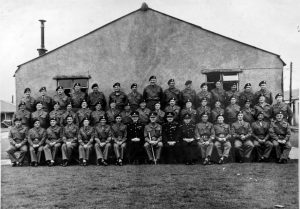
Plasterdown Camp Training DCLI Group 1956
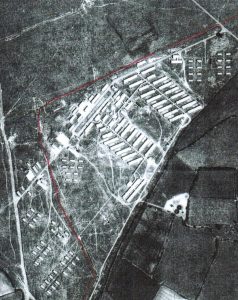
Aerial View of Plasterdown Camp
Drill Halls
Drilling It In!
TA units were based in buildings called Drill Halls which were constructed in nearly two thousand cities, towns and villages across the country . Drill Halls first started to appear in the mid-19th century to provide home bases for the newly created Volunteer and Artillery Volunteer units. These offered paid volunteer roles and were therefore very popular, with more than 120,000 men signed up by 1860.
In the larger towns and cities, Drill Halls were of almost palatial splendour, whilst others looked like ordinary Church Halls. The offices, messes (canteens), stores and armoury were usually housed at the front of the building, whilst the caretaker’s quarters were to the rear. Several examples of Drill Halls can still be found in Cornwall.
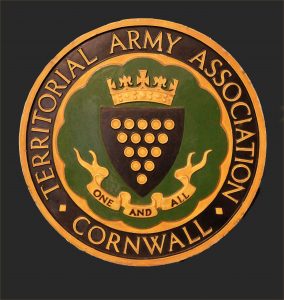
Ceramic Roundel found on the façade of many drill halls, 1930s
During WW2 the Drill Halls were taken over and used by the Home Guard. Today some are still in use around the County whilst others have become clubs, retail outlets or have been demolished.
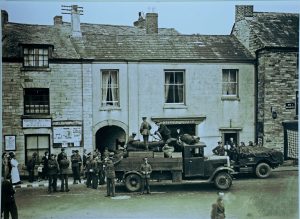
Bodmin Drill Hall, Honey Street
In Cornwall in 1966 there were 19 drill halls for the TA and 4 drill halls for the Army Cadet Forces. The Cornwall Territorial and Auxiliary Forces Association owned 21 drill halls and 11 huts.
As part of the military reorganisation in 1967 the number of Drill Halls in Cornwall was cut from 26 to just 7.
Please click here to find out more about some of Cornwall’s Drill Halls
The DCLI TA Band
And The Band Played On
In 1956 Lostwithiel Town Band became the Band of the D.C.L.I. (T.A) Twenty-two members and four band boys enlisted. Their first Military Bandmaster was a Mr Chapman who had been Bandmaster to the Lahore Police Band in the Punjab, India. Whilst in the TA they did band practice twice weekly, carried out rifle training and some learnt to drive.
The band played at many civic events, including the official opening of the Tamar Bridge by HM the Queen Mother. They also played for HM Queen Elizabeth at the opening of the new County Hall at Truro in 1966 at which the DCLI provided the Guard of Honour.
In 1967 cost-cutting and a massive reorganisation of the Territorial Army led to the Regimental band giving its last concert in April of that year. Today Lostwithiel Town Band is still immensely proud of its military heritage as the DCLI TA Regimental Band. Members of the Hicks family, who served in the DCLI (TA), are still playing with the band.
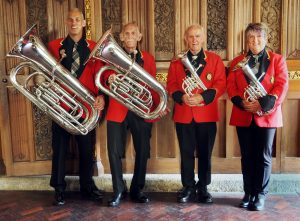
The Modern Reserve Forces
Reforms and restructuring of the military had been taking place over centuries. As methods of warfare have changed, new types of weaponry have been introduced and Regiments were amalgamated the military were required to adapt.
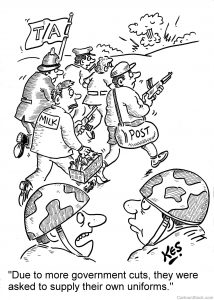
In 2011 Defence Secretary Liam Fox announced planned to cut regular army numbers to 82,000 a 120,000 in total including the Territorial Army (TA) by 2020. It was widely reported this was the smallest it had been since the Boer War.
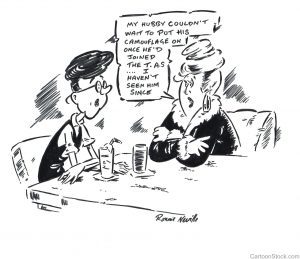
Just 3 years later BBC News reported Defence Secretary Philip Hammond had announced the Territorial Army would be renamed the Army Reserve, they would get regular Army kit, and train with full-time forces. Mr Hammond said that he wanted to see the Army Reserve, as an integral part of the regular Army.
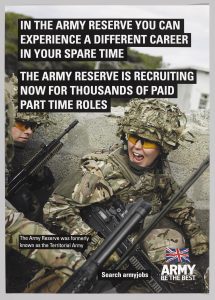
In 2011 under the “Future Reserves 2020” plan outlined by the Secretary of State for Defence at the time, Liam Fox, the Ministry of Defence promised to fund and train more Army reservists. The objective was for reservists, who are not employed full-time by the Army, to play a greater role in providing military capacity, and to deploy entire Army Reserve units, much like United States Army Reserve and Army National Guard.
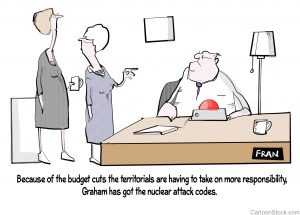
Under this reform plan, the total force was to be restructured so that, by 2020, the British Army would have 120,000 soldiers in total, of which 84,000 would be Regulars and 35,000 would be Reservists (a ratio of 70/30).
In 2014 Defence Secretary Philip Hammond announced that the Territorial Army would be renamed the Army Reserve. They would get regular Army kit and train with full-time forces. The intention was to make the Army Reserve, as an integral part of the regular Army.
In 2018, the British Army comprised just over 81,500 trained regular (full-time) personnel and just over 27,000 trained reserve (part-time) personnel.
The Wessex Wyvern
A West Country Symbol
Territorial Regiments, like their Regular counterparts, were based in groupings, known as Brigades and Divisions. Cornwall’s Territorial Soldiers found themselves in the renowned 43rd Wessex Infantry Division (T.A). This organisation came into being in 1935 and carried on through the Second World War, right up to 1967 when major changes and restructuring took place.
The Wessex Wyvern links the Division with the age-old traditions of the Anglo-Saxon Kingdom of Wessex. It is strongly associated with the West Country and was the emblem of the Wessex Kings. In both Eastern and Northern mythologies, the dragon is the bringer of death and the serpent the symbol of guile. The merging of the snake and the dragon gave birth to the Wyvern, a winged dragon, with two feet like those of an eagle and a serpent-like barbed tail.
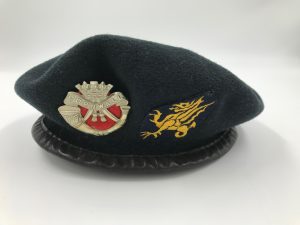
Beret worn by a member of the DCLI 5th Battalion who served in World War 2 at their reunions in the 1950s and 1960s. The badge of the DCLI can be seen alongside the Wessex Wyvern.

